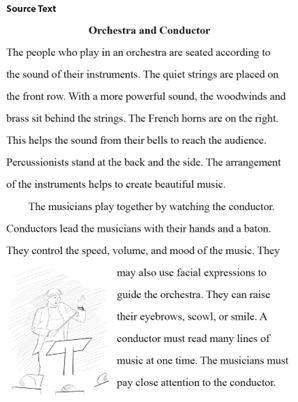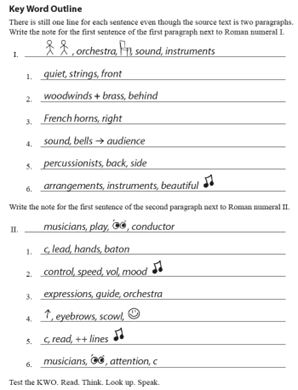
IEW teaches students to write with structure and with style. Style includes vocabulary. Structure is the elements found in compositions. Throughout the year, students progress through nine structural units. Every paper a student writes begins with skills learned in Unit 1: Note Making and Outlines. For this reason, the first year of IEW instruction begins by learning Unit 1, and each subsequent year begins by reviewing Unit 1.
In Unit 1: Note Making and Outlines, students learn to plan to write before they write. The plan is called a key word outline, or KWO. The KWO is the first step of the writing process, where a student organizes his or her thoughts. By writing an outline, a student determines what to write and eliminates the blank page problem.
In Unit 1 students learn or review the basics of the KWO. Instructors and students start with a simple source text included in all the theme-based writing lessons and Structure and Style® for Students video courses. Together, instructors and students read a sentence and choose two or three key words from the sentence. Key words are the most important words that tell the main idea.
To write a KWO, students place two or three key words on the outline. Students may also use symbols, numbers, and abbreviations. They are “free.” Symbols should be drawn faster than it takes to write the word. Symbols are not picture drawing but easily recognized items that can be recalled in the future. Numbers include dates and numerals like 1, 2, 3 and 1st, 2nd, 3rd. Abbreviations are commonly accepted forms of shortened words (b/c, Mr, etc). Students separate key words, symbols, numbers, and abbreviations with commas.
This sample source text and KWO is from Adventures in Writing. The outline contains fourteen lines because the source text contains fourteen sentences, seven sentences in each paragraph. A Roman numeral represents a paragraph. Because this source text has two paragraphs, the KWO has two Roman numerals.


The goal of Unit 1 is to learn how to select key words to write a KWO. For this reason, in Unit 1 students choose key words from every sentence. As students progress through the structural units, they advance in their note making skills and learn to write more sophisticated outlines and subsequently more sophisticated papers as they select key words by asking questions, looking at pictures, and reading source texts.
The primary purpose of a KWO is to write a paper. Therefore, once students write a KWO, they test it. The test is not of the student but of the outline. When students test an outline, they look at the words on a line and form a complete sentence. If a note is unclear, students should look at the source text and fix the outline. They should continue this process until they can easily make a sentence using each line of the KWO.
If a young or remedial student struggles, take turns looking at the key words and forming oral sentences. This type of practice trains students to hear what a complete sentence sounds like.
Writing and testing the KWO is not limited to Unit 1. Throughout the year, students should write a KWO in preparation for every paper they write. In turn, they should test every KWO prior to writing a paper. Testing the KWO proves the outline works and a paper can be written. If the KWO is skimpy, require that students add information before they write. If the KWO is filled with too much information, require that students limit information before they write. As students progress through the units, do not allow them to skip this important step in the writing process.
A secondary use of the KWO is to give an oral report. Do not have students practice this activity until they have tested the outline and it works. When students use the KWO to give an oral report, they should follow the process: Read. Think. Look up. Speak. Andrew Pudewa teaches, “You may look at your notes, and you may speak to your audience, but you may not do both at the same time.”
Why do we repeat Unit 1 year after year? It is tempting for older students to think they have moved beyond this. In truth, one never moves beyond a foundation. We review Unit 1 every year to emphasize that every paragraph begins with a plan and that plan is the KWO. Students organize their thoughts by writing an outline. They prove the outline works when they test it. Walking through the steps of writing and testing the outline will help develop confident and competent communicators and thinkers.
by Heidi Thomas
